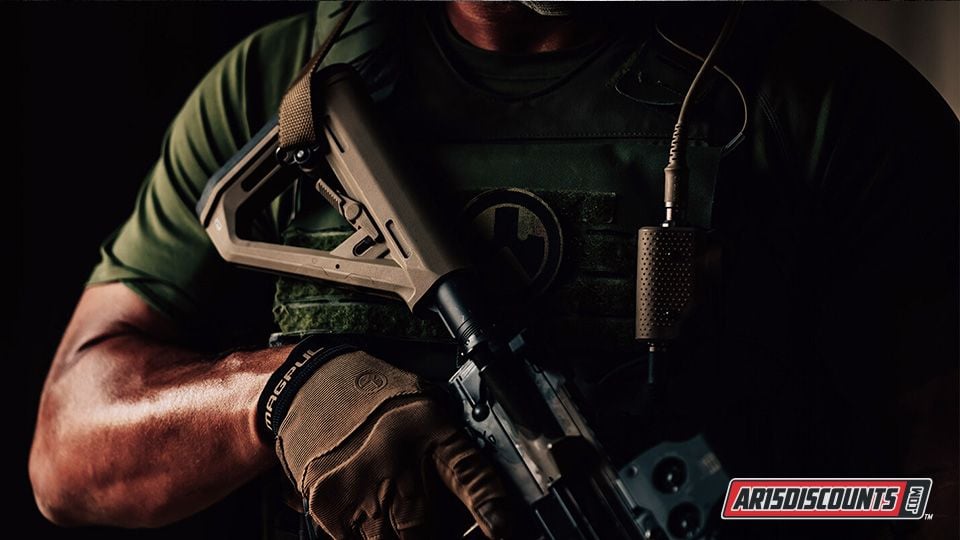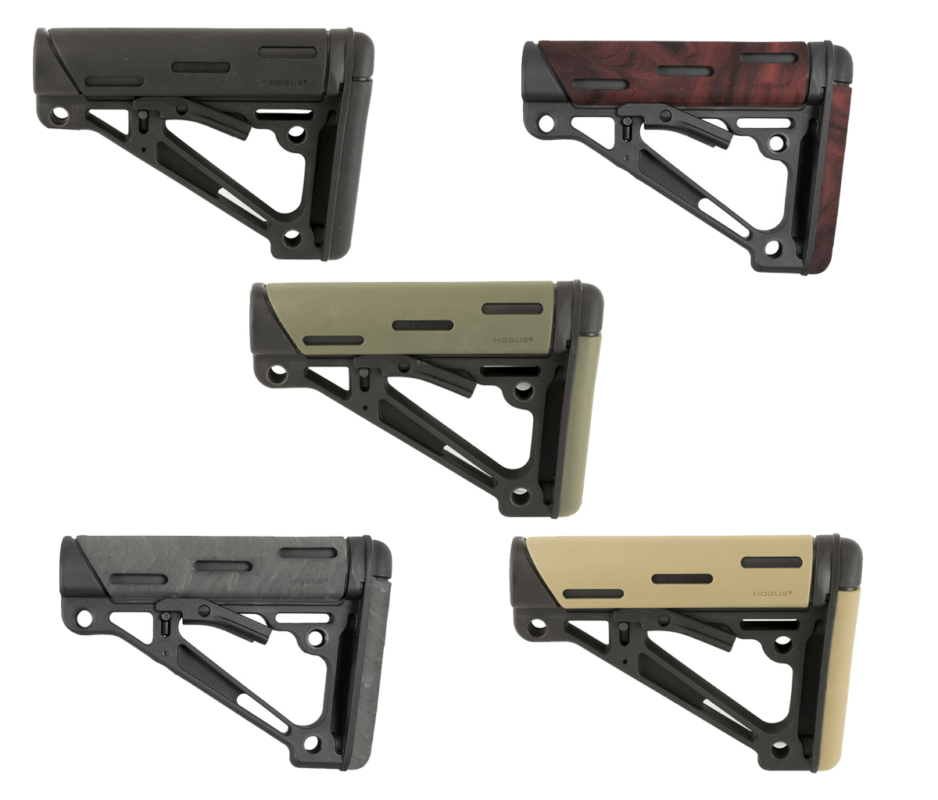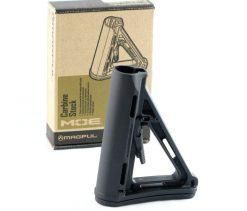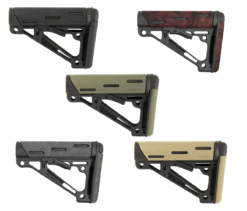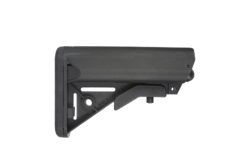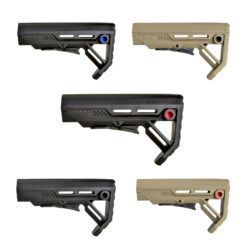AR Rifle
The Perfect AR-15 Rifle Stock for Your Build: A Complete Buyer’s Guide
Table of contents
- What an AR-15 Rifle Stock Actually Does
- Step-by-Step: How to Choose the Perfect AR-15 Rifle Stock
- Step 1: Identify your primary use case
- Step 2: Determine your buffer tube type (Mil-Spec or Commercial-Spec)
- Step 3: Choose fixed or collapsible
- Step 4: Consider cheek weld & riser needs
- Step 5: Assess materials & ergonomics
- Step 6: Decide on sling attachment style
- Step 7: Evaluate brand reputation & aftermarket support
- Step 8: Browse parts, compare specs & verify compatibility
- Mil-Spec vs. Commercial-Spec Explained
- Fixed vs. Collapsible AR-15 Rifle Stocks
- Key Factors to Evaluate (Cheek Pads, M-LOK, Materials, Weight & More)
- Best AR-15 Rifle Stock Types for Different Uses
- Top Brands & Aftermarket Stock Options
- Frequently Asked Questions About AR-15 Rifle Stocks
Welcome to AR15Discounts.com — the builder’s choice for deals on AR-15 Rifle parts, kits, accessories, and more. Whether you’re upgrading an existing rifle or planning your next build from the ground up, selecting the right AR-15 rifle stock shapes how the gun fits, handles, and performs. The market is packed with innovative options, from lightweight synthetic rifle stocks to precision-focused MDT rifle stocks and do-everything Magpul rifle stocks. But each option brings its own feel, geometry, and purpose.
This complete buyer’s guide breaks down every major factor: commercial vs. Mil-Spec specifications, fixed vs. collapsible configurations, weight considerations, cheek weld features, sling options, and category-specific recommendations. We’ll also walk you through a high-level, step-by-step selection process so you can confidently choose the perfect AR-15 rifle stock for your build.
You’ll also see references to popular, proven brands—Magpul, MDT, Hogue, BCM, and more—with recommended categories linked via relevant anchor text for easy browsing.
What an AR-15 Rifle Stock Actually Does
Your rifle stock is more than just a shoulder interface—it’s the foundation of how the rifle balances, absorbs recoil, and aligns with your eye and cheek. At a high level, AR-15 rifle stocks perform four essential functions:
1. Stability & recoil control
A well-fitting stock allows you to shoulder the rifle naturally and maintain precise sight alignment under recoil. Heavier precision rifle stocks—such as those made by MDT—soak up recoil and help deliver predictable follow-up shots. Lightweight synthetic stocks for rifles, on the other hand, keep maneuverability high while reducing recoil.
2. Fit, length of pull & cheek weld
The right length of pull (LOP) and cheek height directly impact your comfort and accuracy. Many aftermarket options—exceptionally adjustable MDT stock rifle models or GRS rifle stock designs—offer flexible cheek risers or can accept a rifle stock cheek pad for better alignment.
3. Sling-mounting capability
Most modern AR rifle stocks include QD (quick-detach) sling sockets or can accept them as add-ons. Some also integrate M-LOK slots, giving you accessory flexibility similar to a rifle stock with an M-LOK fore-end.
4. Shoulder comfort & ergonomics
Rubberized butt pads, textured surfaces, and angled toe designs improve stability during both home-defense movement and precision-oriented positional shooting.
Whether you’re chasing the best aftermarket rifle stocks for customization or keeping things simple with a Magpul MOE rifle stock, your choice has real consequences for handling. With that foundation, let’s walk through a transparent, safe, step-by-step process for selecting your ideal configuration.
Step-by-Step: How to Choose the Perfect AR-15 Rifle Stock
This guide is intentionally high-level and non-technical. Always follow manufacturer instructions for installation and consult a qualified gunsmith for armorer-level work.
Step 1: Identify your primary use case
Different roles demand different strengths. Precision shooting thrives on rigidity and adjustability, while home defense benefits from compact, maneuverable designs.
Examples:
- Precision rifle stocks → MDT stock rifle, GRS rifle stock
- General-purpose → Magpul rifle stocks like MOE SL
- Budget builds → Boyd’s rifle stocks, synthetic stocks for rifles
- Competition → Lightweight collapsible AR rifle stocks
Step 2: Determine your buffer tube type (Mil-Spec or Commercial-Spec)
This dictates compatibility. Mil-Spec is the most common and widely supported. We’ll cover this in detail shortly.
Step 3: Choose fixed or collapsible
A collapsible stock offers adjustability; a fixed stock provides rigidity. Both are legal to own federally, but always check state and local laws.
Step 4: Consider cheek weld & riser needs
A rifle stock cheek pad or an adjustable riser may be essential if you use magnified optics or night-vision accessories.
Step 5: Assess materials & ergonomics
Synthetic polymer? Reinforced composites? Aluminum chassis-style? Each offers pros and cons regarding durability, weight, and comfort.
Step 6: Decide on sling attachment style
Look for built-in QD mounts or M-LOK slots if you prefer particular sling setups.
Step 7: Evaluate brand reputation & aftermarket support
Brands like MDT rifle stocks, Magpul rifle stocks, GRS, and Boyds rifle stocks offer reliable fit, strong warranties, and a wide range of accessories.
Step 8: Browse parts, compare specs & verify compatibility
Before purchasing, compare stock weight, LOP range, cheek height, and whether the stock works with your existing build components.
Mil-Spec vs. Commercial-Spec Explained
The Mil-Spec vs. commercial conversation confuses many new builders, but the differences are simple and revolve around the buffer tube.
Mil-Spec
- Most common modern standard
- Slightly smaller outer diameter (~1.148″)
- Stronger receiver extension (forged)
- Broadest compatibility with AR rifle stocks on the market
Commercial-Spec
- Slightly larger (~1.168″)
- Typically extruded rather than forged
- Fewer stock options, but still reliable
- Familiar with older civilian rifles
Which should you choose?
For maximum aftermarket flexibility, Mil-Spec is recommended. Most aftermarket rifle stocks are produced in Mil-Spec variants. If you already have a commercial buffer tube, you can absolutely shop for commercial rifle stocks, but ensure your spec matches the product listing exactly.
Compatibility rule:
A Mil-Spec stock goes on a Mil-Spec tube; a commercial stock goes on a commercial tube. They are not cross-compatible.
Fixed vs. Collapsible AR-15 Rifle Stocks
Both configurations remain popular, and picking the right one depends entirely on your intended application.
Fixed Stocks
Fixed stocks—such as some MDT rifle stocks or Boyds rifle stocks—offer:
- Excellent stability
- Consistent cheek weld
- Better balance for long-range optics
- Room for add-on cheek pads or the best rifle stock ammo holder options
Ideal for:
- Precision shooting
- Heavier calibers
- Bench/rest shooting
Collapsible Stocks
Collapsible stocks—like the Magpul MOE rifle stock—are:
- Adjustable for the length of the pull
- Great for multi-shooter households
- More maneuverable in confined spaces
- Lighter, often improving handling
Ideal for:
- Home defense
- Competition
- Dynamic shooting courses
A collapsible stock can also work with specific cheek pads and accessories, but stability won’t match that of a fixed-precision rifle stock.
Key Factors to Evaluate (Cheek Pads, M-LOK, Materials, Weight & More)
When comparing AR-15 rifle stocks, these are the factors that impact real-world performance:
1. Cheek Weld & Adjustability
Cheek pads significantly help with optic alignment, particularly on precision builds. Some stocks offer adjustable cheek risers (e.g., MDT or GRS systems); others require an add-on cheek pad for the rifle stock.
2. Accessory Mounting (M-LOK, QD, Etc.)
While not typical for the buttstock area, some advanced models include a rifle stock with M-LOK slots for sling attachments or small accessories. Most AR-15 stocks offer QD mount points; check product listings for specifics.
3. Material Choice
- Synthetic stocks for rifles = lightweight, durable, weather-resistant
- Polymer AR-15 stocks = affordable, feature-rich
- Aluminum chassis stocks (e.g., MDT) = highly rigid, ideal for precision shooters
4. Weight
Weight affects recoil control, fatigue, and maneuverability. Lighter stocks help in CQB scenarios; heavier ones calm recoil during slow-fire precision.
5. Ergonomics
Toe angle, buttpad texture, and grip interface shape the rifle’s natural point of aim.
6. Aftermarket Support
Look for brands with replacement parts, cheek risers, butt pads, and compatible sling hardware.
Best AR-15 Rifle Stock Types for Different Uses
Precision Shooting
- MDT rifle stocks
- GRS rifle stock
- Fixed chassis-style designs with cheek risers
- Accepts rifle stock cheek pad and sometimes ammo holders
Home Defense / CQB
- Magpul MOE rifle stock
- Lightweight collapsible AR rifle stocks
- Compact buffer tube compatibility
- Options that support QD mounts for quick sling transitions
Competition Shooting
- Lightweight models
- Adjustable LOP
- Good recoil management
- Often, polymer or hybrid stocks
Budget / Utility Builds
- Boyds rifle stocks
- Synthetic stocks for rifles
- Simple, durable, and cost-effective
VR Rifle Training Applications
Some shooters prefer VR rifle stock setups designed for simulation rigs. These enhance training realism but are unrelated to firearm performance; use them only for VR.
Top Brands & Aftermarket Stock Options
AR15Discounts.com carries many of the most trusted stock manufacturers in the industry. Here are some standout categories to explore:
- Magpul rifle stocks – Durable, balanced, budget-friendly
- Magpul MOE rifle stock – Classic all-purpose collapsible upgrade
- MDT rifle stock – Premium precision rifle stocks built for accuracy
- Boyds rifle stocks – Affordable and durable traditional stock designs
- GRS rifle stock – Ergonomic precision stocks with adjustability
Each brand offers products across a range of budgets and skill levels. Browse their product lines using the keyword-rich hyperlinks below.
Frequently Asked Questions About AR-15 Rifle Stocks
Choosing the right AR-15 rifle stock can feel overwhelming with so many materials, configurations, and compatibility considerations to sort through. Whether you’re planning your first build or upgrading a well-loved rifle, it’s normal to have questions about specs, features, and what matters most for your style of shooting. The FAQs below break everything down in clear, practical terms to help you shop confidently and match the perfect stock to your build’s purpose.
Start with your intended use—precision shooting, home defense, or competition—then assess comfort features such as cheek weld, length-of-pull adjustability, weight, and sling-mounting options. Make sure the stock is compatible with your buffer tube (Mil-Spec or Commercial-Spec), and consider material options such as polymer, synthetic composites, or aluminum chassis systems, depending on durability and recoil-control preferences.
Fixed stocks offer rigidity and a consistent cheek weld, making them popular for precision applications. Collapsible stocks allow you to adjust the length of pull, improving maneuverability and making the rifle adaptable to different shooters and shooting positions. Each has a role, and neither is universally better—it really depends on your build goals.
The easiest way is to confirm whether your tube is Mil-Spec or Commercial-Spec. Mil-Spec tubes are slightly smaller and more common on modern builds. A stock must match the tube type exactly—Mil-Spec stocks won’t fit commercial tubes, and commercial stocks won’t fit Mil-Spec extensions.
Mil-Spec stocks have broader aftermarket support, tighter tolerances, and are generally made from stronger materials. Commercial-Spec stocks can work just as well but have fewer compatible options. If you’re starting a new build and want as many choices as possible, Mil-Spec is usually the way to go.
Heavier stocks absorb more recoil and help stabilize the rifle for slower, deliberate shots—ideal for precision setups. Lighter stocks make the gun easier to shoulder quickly, navigate indoors, and maintain during a long day of training or competition. Choose the weight that complements your shooting environment and goals.
For precision shooting, adjustable stocks with cheek risers and longer LOP options offer superior alignment and stability. Home-defense rifles benefit most from lightweight, collapsible stocks for improved maneuverability. Competitive shooters lean toward balanced, lighter setups that offer quick transitions and customizable ergonomics.
Build With Confidence & Choose the Right AR-15 Rifle Stock
Finding the perfect AR-15 rifle stock is all about aligning comfort, performance, and purpose. Whether you’re leaning toward a lightweight collapsible design for home defense, a precision-tuned chassis system for long-range work, or a rugged synthetic stock for all-around utility, the right fit transforms how your rifle handles and feels.
At AR15Discounts.com, you’ll find a curated selection of proven options—from Magpul rifle stocks to MDT and Boyds—backed by competitive pricing and customer support that understands builders. If you’re ready to upgrade your setup or finish your next build, explore our full collection of AR-15 rifle stocks and get the performance, value, and reliability your rifle deserves.
For additional resources, www.ditybirdusa.com

